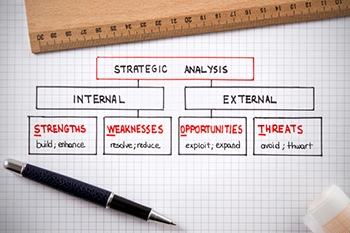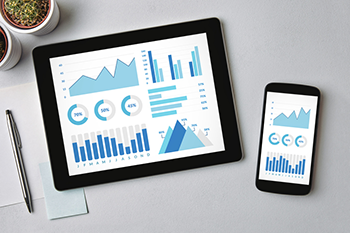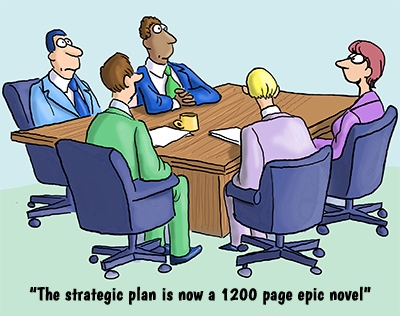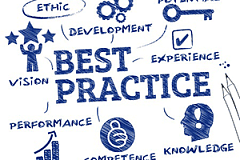 Since the beginning of the COVID-19 pandemic, you may have felt like your business has been in a tailspin. You’ve tried to move your workforce to a remote footing, stay engaged with your customers, and find new ways to market products and services to a population that’s staying at home more and spending less.
Since the beginning of the COVID-19 pandemic, you may have felt like your business has been in a tailspin. You’ve tried to move your workforce to a remote footing, stay engaged with your customers, and find new ways to market products and services to a population that’s staying at home more and spending less.
But you must keep looking to the future and have your plans ready for a strong launch into 2021. [quotes]Next year, you need to be off and running before the competition even realizes the bell has rung. [/quotes]
A good plan takes time to develop, communicate, and get the input and buy-in needed to be highly successful. Start immediately!
What is a Strategic Plan?
In simple terms, a strategic plan defines how to turn your vision for your company into a reality which is consistent with your values.
A strategic plan is effectively a road map for your business to get from where you are now to where you want to be. This plan looks at all the assets and tools you have at your disposal now, as well as the challenges you’re facing. It also focuses on where you want your business to be at the end of a certain period of time – three months, a year, three years, and so on into the future.
Once you know where you are and where you want to be, your strategic plan will drive the specific steps you’ll take to get there. This must include crystal clear and important objectives (goals) and clearly defined actions that your team will take to accomplish those objectives.
A strategic plan is a living document, not a hardened relic. [quotesright]As your business grows, changes, and faces new challenges, your strategic plan must change with it. [/quotesright]
Importance of a Strategic Plan
Having an effective strategic plan is crucial to growing your small business in the way you want. Without a strategic plan, your business wanders and can spin out of control, becoming something you don’t want it to be. Without a plan, it can stagnate, going nowhere for years while you waste resources on failed growth efforts.
Yogi Berra, famously said, “When you come to a fork in the road, take it.” Don’t let that be your approach.
A strategic plan gives your business clarity of purpose and directed action, a way to prioritize addressing the most important things first. It’s your compass, a strong sense of direction, helping you to grow in productive ways that propel you toward realizing your vision and values. [quotesright]A strategic plan gives employees day-to-day tasks that are laser focused on moving your company forward. [/quotesright]
And when you run into unexpected challenges – a global pandemic, for instance – your strategic plan can serve as a framework to effectively respond to the crisis.
Set Your Company Vision
 You start with why. Why are you doing all this work, taking all this risk? What do you want the end result to be when it’s time to hang up your spurs? What is your vision for your company five, ten, fifteen years out?
You start with why. Why are you doing all this work, taking all this risk? What do you want the end result to be when it’s time to hang up your spurs? What is your vision for your company five, ten, fifteen years out?
Take time to decide what you want your business to be. Start with more abstract, broader concepts. Maybe you want your business to become an industry leader, find cures that help people get over diseases like COVID-19, or be able to support initiatives in your community.
Once you’ve got a broad ideal pinned down, start getting more specific. What kind of company culture do you want, and how do you want to interact with your customers? What sort of atmosphere do you want your business to have, and what legacy do you want to leave?
Speaking of COVID-19
This pandemic has changed everything about how we run our lives, from where employees work to how our children attend school. Many businesses have had to shut down for months or find new ways to engage with your customers.
Begin by sitting down and taking a long look at all the ways COVID-19 has changed the way you do business. Look at the financial impact, the toll it’s taken on your employee morale and company culture, and the way it’s affected your customer relations.
As you’re making a plan going forward, don’t forget to plan for how COVID-19 will continue to impact your business and don’t forget to consider the aftershocks that will come from economic impact, societal change, the way businesses interact, and more.
Complete a SWOT Analysis
How the pandemic has changed your business is an example of just one threat (and opportunity) that you must take into account. You do this by conducting a SWOT analysis. A SWOT analysis examines the Strengths, Weaknesses, Opportunities, and Threats your business faces.
[sidebar]
Learn About Your Competitors
(So You Can Be Nothing Like Them)
Military strategist Sun Tzu famously wrote in his book Art of War, “It is said that if you know your enemies and know yourself, you will not be imperiled in a hundred battles; if you do not know your enemies but do know yourself, you will win one and lose one; if you do not know your enemies nor yourself, you will be imperiled in every single battle.”
Know your competitors. Know your enemy.
Where are they strong and weak? Talk to their customers. Read their reviews. Figure out where they’re falling short and lean into that. Don’t just slavishly copy what they’re doing. Discover the weaknesses in their business and make them your strengths.
[/sidebar]
 Take a look at what strengths your business has had that has helped it through the course of the pandemic, as well as the areas where it has faltered and been weaker. Explore what sort of opportunities the new market offers your business. Be sure to work out what sort of threats – pandemic aside – your business will face short and longer term.
Take a look at what strengths your business has had that has helped it through the course of the pandemic, as well as the areas where it has faltered and been weaker. Explore what sort of opportunities the new market offers your business. Be sure to work out what sort of threats – pandemic aside – your business will face short and longer term.
[quotes]It’s not all doom and gloom.[/quotes] Every threat is also a great opportunity so consider how you can turn a problem to your advantage. Can you invest in building employee skills or improve your sales team by training or replacing low performers with highly skilled sales people who may have been let go by another company?
Where is your company weakest, most vulnerable? Plan precisely how you will turn your greatest weakness into your greatest strength. (Tip: keep doing that again and again until you work your way through all your weaknesses and you’ll build an astoundingly robust and successful company…life too, if you stop to think about it.)
[quotes]It is not just you doing the thinking, this must be a team effort if it is to succeed.[/quotes] That means you absolutely must involve all your key staff and top managers in developing and implementing “our” plan. You’ll find better solutions than you ever could have alone when you take advantage of the knowledge of those closest to your customers. Amazingly, you’ll come up with great ways to cut costs, be more effective, and have happier, more engaged employees in the process.
Create a Plan That Everyone Lives By – and Can Use
 Once you know where you want your business to go, you and your planning team can start laying out your road map to get there. Creating the plan is the process of working backwards from the key objectives you want to accomplish this year, to breaking down how you are going to make those happen.
Once you know where you want your business to go, you and your planning team can start laying out your road map to get there. Creating the plan is the process of working backwards from the key objectives you want to accomplish this year, to breaking down how you are going to make those happen.
This is a process of deconstructing the year’s key objectives into successively smaller objectives for divisions, groups, departments, teams, and sometimes even individuals. Part of making this successful is that it is an incredibly open process so everyone understands how they fit in helping their team, group, division and the company reach your key objectives.
A great strategic plan that is left unused and fails to serve as a daily guide to what every department should be focused on is almost worthless. The plan must be something you can use.
 Most plans lack two things: brevity and extreme actionability. Better than a 1200-page doorstop is a one-page strategic plan that serves as a compass for your company to follow. It fits in one hand and almost anyone can understand it easily with just a little instruction. Just follow where it points.
Most plans lack two things: brevity and extreme actionability. Better than a 1200-page doorstop is a one-page strategic plan that serves as a compass for your company to follow. It fits in one hand and almost anyone can understand it easily with just a little instruction. Just follow where it points.
In preparation for doing the deconstruction and writing the objectives, let’s review the foundational concepts of how to set SMART Objectives (goals). This acronym stands for Specific, Measurable, Attainable, Relevant, and Time-based. If you set goals that meet all of these standards, you’ll have a much easier time writing your key objectives.
[sidebar]
Get HelpToday
Making Your Strategic Planning Work
If you’d like help developing and putting your strategic plan into practice this year and to discover more great ways to strengthen your business, check out our website or get in touch and let's set up a time to talk. Brian Tracy USA: 877.433.6225 Email Me On the web: http://www.focalpointcoaching.com/
We will work alongside you to create a solid plant so you get moving and eliminate those aggravations that steal your sanity.
Start building your vision for what your company can be beginning right now.
[/sidebar]
Start with Key Objectives
There is a right way to word key objectives.
Work one key objective at a time, starting with where you are and deciding what are the steps that must be accomplished to achieve that objective. To be useful, it must be something that anyone can look at and definitively say “Done” or “Not Done.” That’s the “Measurable” part. Strategic should mean it is uber important. Remember, you cannot do everything – time and resources are not infinite! Time based is key in that you need to establish a deadline within which the objective will be accomplished. Being both Attainable and Relevant means that there should not be a mystery about why they are included!
[quotes]Anything is possible, everything is not.[/quotes] Not all objectives are created equal, some are far more important than others. Keeping in mind that a company can only take on and accomplish three to seven key strategic objectives in a year, and any group within the company can only achieve three to five major objectives in a year, what will those be?
This forces you to pick; everything is not possible. Pick the big ones and get them done. If you finish early, take on the next most important objective.
Track Your Progress
When your strategic plan is complete, it may feel like the work is done. But in fact, it’s only just beginning; making your plan is only half the job. Now you will need to implement it in your day-to-day operations and keep track of your progress.
Build in procedures to check your progress during your daily operations. Set up reporting, establish helpful metrics, and make plans to check on your goals on a regular basis. If you notice you’re not meeting certain goals on schedule, sit down with your team to make new plans for tackling those goals.
[quotes]This has always been a huge problem and frustration in business.[/quotes] Progress reports are home to some very creative writing. Lip service, whining, and complaints of wasting time abound. Too many progress reports go into the great black hole at the center of every company, never to be seen again.
Until, of course, that eagerly awaited year-end evaluation. You know, that exercise in blame shifting, artful turning of phrase and creativity to explain how failing to get something done was thwarted by agents of Satan, asteroid strikes, and other departments.
There is a far better strategy and that is to use a system that breaks down key objectives into concrete measurable blocks of work that we call Key Results that must be accomplished every quarter, every month, and even every week to accomplish a key objective. [quotesright]This breaks things down so you can measure what matters and immediately know where teams are running into problems and help them get progress back on track. [/quotesright]
That same strategy eliminates the creative writing because it unambiguously measures progress toward accomplishing Key Results each week, month, and quarter in such a way that anyone can tell if they were either completed or not completed. The same thing occurs at the end of the year. You’ll know you accomplished your most important objectives and moved the business forward.
Build a Strong Strategic Plan
Having a strong strategic plan for your business is a good idea at any time, but it’s especially critical in the aftermath of COVID-19 and the societal and economic aftershocks that are sure to follow. Your plan will guide your business in how you respond to this crisis and help you come out the other side stronger than ever. Take a long look at where you want to go and develop a plan to get there… ahead of the other guys.













